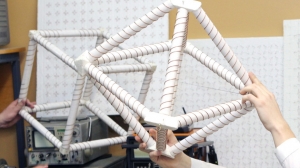Research standards of young Belarusian physicists praised

MINSK, 26 April (BelTA) – Research projects carried out by young Belarusian physicists are at a high international level. Chairman of the Belarusian Physical Society Dmitry Mogilevtsev mentioned it during the solemn opening of the 7th congress of Belarusian physicists. The congress was timed to the 110th anniversary since the academician Boris Stepanov was born, BelTA has learned.
In his speech Dmitry Mogilevtsev reminded that the first congress of Belarusian physicists took place in 2005 when the United Nations Organization declared the World Year of Physics.
Dmitry Mogilevtsev said: “Today we celebrate virtually the coming of age of the congress since it has been 18 years since the first congress. We've seen a lot of problems since then but the most important thing is that the society and the congress continue working. The Belarusian Physical Society is quite busy: popular lectures are arranged as well as the training of school students for physics competitions and contests. We still participate in the work of the European Physical Society. Every year we have a contest for the best scientific work among young scientists. I'd like to note that the works that get presented before us are at a high international level. All of it gives us no doubt that the physical society will live and will continue developing.”
The 7th congress of Belarusian physicists has been organized by the National Academy of Sciences of Belarus, the B.I. Stepanov Physics Institute of the National Academy of Sciences of Belarus, Belarusian State University, the public association Belarusian Physical Society, and the Belarusian Republican Foundation for Fundamental Research. The congress is scheduled to take place in Minsk on 26-28 April.
Participants of the congress are expected to discuss the development of physics in Belarus, hear out reports from leading scientists and debate how physics can play a more prominent role in people's lives. Foreign guests have been invited to participate in the congress and are expected to contribute to discussions about a broad range of matters such as physics of fundamental interactions; laser physics and photonics; physics of nanostructures, solid state and semiconductors; plasma physics; biophysics; physics and informatics; physics teaching and the training of physicists.













